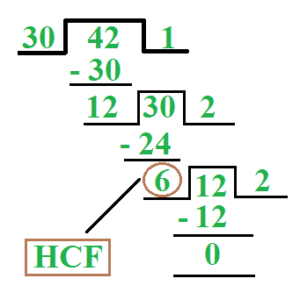LCM and HCF Formulas, Shortcuts and Tricks with Examples
LCM and HCF Short Tricks with Examples
Factors and Multiples:
- If number p divided another number q exactly, we say that p is a factor of q.
- In this case, q is called a multiple of p.

Common Multiple :
A number which is exactly divisible by all the given numbers is “Common multiple”.
Least Common Multiple (LCM) :
The least number which is exactly divisible by all the given numbers is LCM.

Common Factor:
A number which divides all the given numbers exactly is “Common factor”.
Highest Common Factor (HCF):
The greatest number that divides all the given numbers exactly is “HCF”.
H.C.F by Method of Prime Factors:
(1) H.C.F or G.C.F of 18 and 24?

H.C.F by Method of Division:
(1) H.C.F of 30 and 42?

H.C.F and L.C.M of Fractions:

Co-primes: Two numbers are said to be co-primes if their H.C.F. is 1.
L.C.M and HCF Important Formulas
- Product of two numbers (First number x Second Number) = H.C.F. X L.C.M.
- H.C.F. of a given number always divides its L.C.M.
- To find the greatest number that will exactly divide x, y and z. Required number = HCF of x, y and z
- To find the Largest number that will divide x, y and z leaving remainders a, b and c respectively. Required number = HCF of (x -a), (y- b) and (z – c)
- To find the least number which is exactly divisible by x, y and z. Required number = LCM of x, y and z
- To find the least number which when divided by x, y and z leaves the remainders a, b and c respectively. It is always observed that, (x – a) = (y – b) = (z- c) = K (say). Required number = (LCM of x, y and z) – K.
- To find the least number which, when divided by x, y and z leaves the same remainder r in each case. Required number = (LCM of x, y and z) + r
- To find the greatest number that will divide x, y and z leaving the same remainder ‘r’ in each case. Required number = HCF of (x -r), (y- r) and (z- r)
- Largest number which divides x, y, z to leave same remainder = H.C.F. of (y-x), (z-y), (z-x).
- HCF of two prime numbers is always 1.
- To find the n-digit greatest number which, when divided by x, y and z,
(i) leaves no remainder (ie exactly divisible)
Following step wise methods are adopted.
Step I: LCM of x, y and z = L
Step II: L) n-digit greatest number (
Remainder (R)
Step III: Required number = n – digit smallest number + (L – R)
(ii) Leaves remainder K in each case
Following step-wise method is adopted.
Step I: LCM of x, y and z = L
Step II: L) n-digit greatest number (
Remainder (R)
Step III: Required number = (n-digit greatest number – R) + K - To find the n – digit smallest number which, when divided by x, y and z.(i) Leaves no remainder (i.e. exactly divisible)
Following steps are followed.
Step I: LCM of x, y and z = L
Step II: LCM) n-digit smallest number (
Remainder (R)
Step III: The required number = n-digit smallest number + (L – R)
(ii) leaves remainder K in each case.
Step I: LCM of x, y and z = L
Step II: LCM) n-digit smallest number (
Remainder (R)
Step III: Required number = n – digit smallest number + (L – R) + K - To find the least number which on being divided by x, y and z leaves in each case a remiander R, but when divided by N leaves no remainder, following step-wise methods are adopted.
Step I: Find the LCM of x, y and z say (L).
Step II: Required number will be in the form of (LK + R); where K is a positive integer.
Step III: N) L (Quotient (Q)
—–
Remainder (R0)
∴ L = N X Q + R0
Now put the value of L into the expression obtained in step II.
∴ required number will be in the form of (N × Q + R0) K + R
or, (N × Q x K) + (R0K + R)
Clearly N x Q x K is always divisible by N.
Step IV: Now make (R0K + R) divisible by N by putting the least value of K. Say, 1, 2, 3, 4….
Now put the value of K into the expression (LK + R) which will be the required number. - There are n numbers. If the HCF of each pair is x and the LCM of all the n numbers is y, then the product of n numbers is given by or Product of ‘n’ numbers = (HCF of each pair)n-1 × (LCM of n numbers).
We gain very important knowledge from your example of LCM,HCF
Good work
Nice presentation …
????☺️☺️☺️☺️☺️
?????????????
Really very good
Thank you so much for sending this email,it’s very very useful
Nice solution